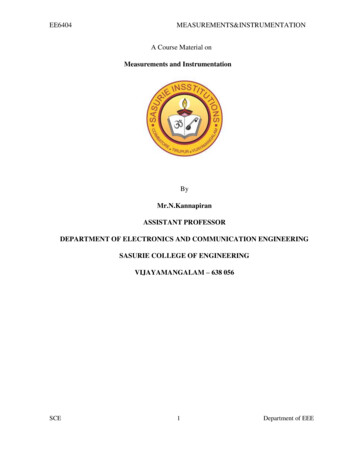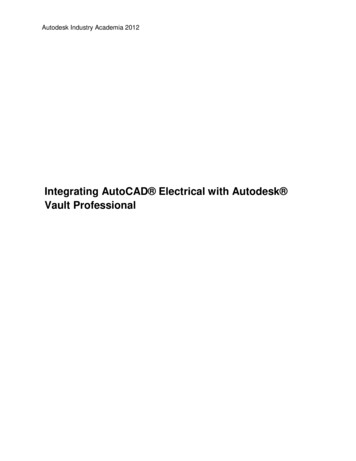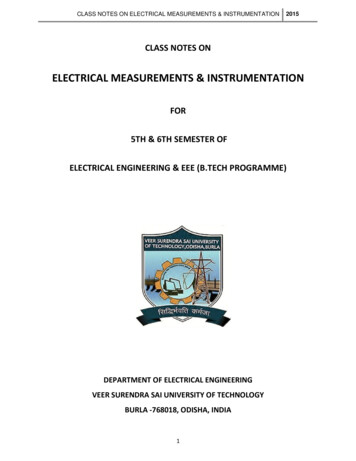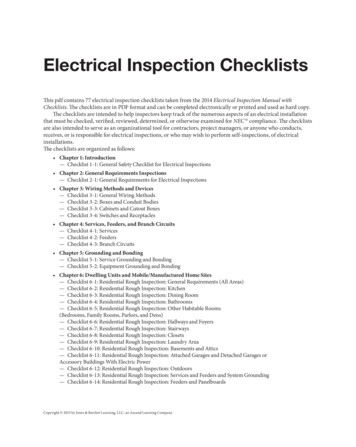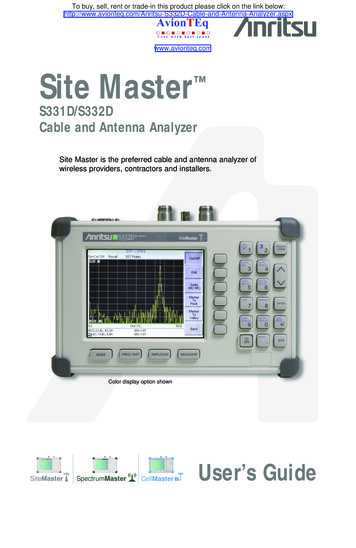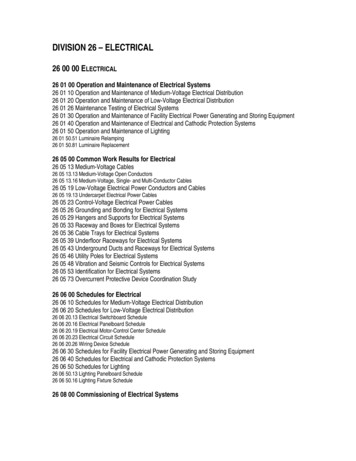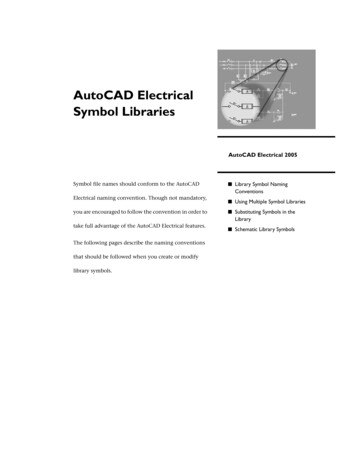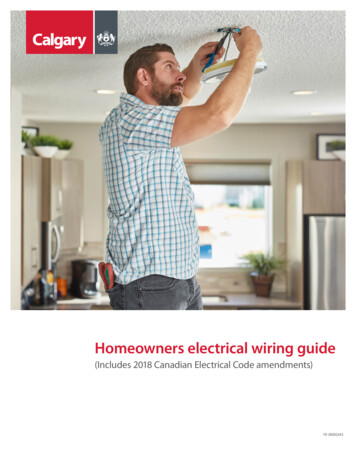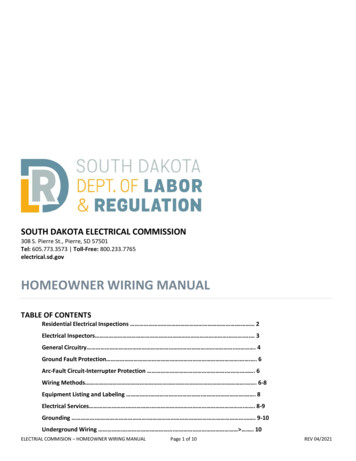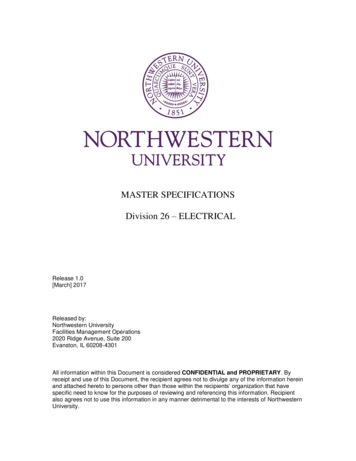
Transcription
Course File OnElectrical Measurements and InstrumentationByCh RamaiahAssistant Professor,Electrical and Electronics EngineeringK. G. Reddy College Of Engineering andTechnology2018-2019HODEEEPrincipalKGRCET
COURSE FILESubject: Electrical Measurements andInstrumentationName: CH RAMAIAHDesignation: Assistant ProfessorRegulation /Course Code: R 16 / EE501PCYear / Semester: III / IDepartment: EEEAcademic Year: 2018-19
COURSE FILE CONTENTSPART-1S.N.TopicsPage No.1Vision, Mission, PEO’s, PO’s & PSOs62Syllabus (University Copy)93Course Objectives, Course Outcomes and Topic Outcomes114Course Prerequisites155CO’s, PO’s Mapping166Course Information Sheet (CIS)17a). Course Descriptionb). Syllabusc). Gaps in Syllabusd). Topics beyond syllabuse). Web Sources-Referencesf). Delivery / Instructional Methodologiesg). Assessment Methodologies-Directh). Assessment Methodologies –Indirecti). Text books & Reference books7Micro Lesson Plan218Teaching Schedule249Unit wise Hand written Notes10OHP/LCD SHEETS /CDS/DVDS/PPT (Soft/Hard copies)11University Previous Question papers2512MID exam Descriptive Question Papers with Key28
13MID exam Objective Question papers with Key3914Assignment topics with materials4315Tutorial topics and Questions8016Unit wise-Question bank1Two marks question with answers5 questions2Three marks question with answers5 questions3Five marks question with answers5 questions4Objective question with answers10 questions5Fill in the blanks question with answers10 questions17Beyond syllabus Topics with material18Result Analysis-Remedial/Corrective Action19Record of Tutorial Classes20Record of Remedial Classes21Record of guest lecturers conducted81162
PART-2S.N.Topics1Attendance Register/Teacher Log Book2Time Table3Academic Calendar4Continuous Evaluation-marks (Test, Assignments etc)5Status Request internal Exams and Syllabus coverage6Teaching Diary/Daily Delivery Record7Continuous Evaluation – MID marks8Assignment Evaluation- marks /Grades9Special Descriptive Tests Marks10Sample students descriptive answer sheets11Sample students assignment sheets
1. VISION, MISSION, PROGRAM EDUCATIONAL OBJECTIVESVISIONTo become a renowned department imparting both technical and non-technical skills to thestudents by implementing new engineering pedagogy’s and research to produce competentnew age electrical engineers.MISSION To transform the students into motivated and knowledgeable new age electrical engineers. To advance the quality of education to produce world class technocrats with an ability toadapt to the academically challenging environment. To provide a progressive environment for learning through organized teachingmethodologies, contemporary curriculum and research in the thrust areas of electricalengineering.PROGRAM EDUCATIONAL OBJECTIVESPEO 1: Apply knowledge and skills to provide solutions to Electrical and ElectronicsEngineering problems in industry and governmental organizations or to enhance studentlearning in educational institutionsPEO 2: Work as a team with a sense of ethics and professionalism, and communicateeffectively to manage cross-cultural and multidisciplinary teamsPEO 3: Update their knowledge continuously through lifelong learning that contributes topersonal, global and organizational growthPROGRAM OUTCOMESPO 1: Engineering knowledge: Apply the knowledge of mathematics, science,engineering fundamentals and an engineering specialization to the solution of complexengineering problems.PO 2: Problem analysis: Identify, formulate, review research literature, and analyzecomplex engineering problems reaching substantiated conclusions using first principles ofmathematics, natural science and engineering sciences.PO 3: Design/development of solutions: design solutions for complex engineeringproblems and design system components or processes that meet the specified needs withappropriate consideration for the public health and safety, and the cultural, societal andenvironmental considerations.
PO 4: Conduct investigations of complex problems: use research based knowledge andresearch methods including design of experiments, analysis and interpretation of data, andsynthesis of the information to provide valid conclusions.PO 5: Modern tool usage: create, select and apply appropriate techniques, resources andmodern engineering and IT tools including prediction and modeling to complexengineering activities with an understanding of the limitations.PO 6: The engineer and society: apply reasoning informed by the contextual knowledgeto assess societal, health, safety, legal and cultural issues and the consequentresponsibilities relevant to the professional engineering practice.PO 7: Environment sustainability: understand the impact of the professionalengineering solutions in the societal and environmental contexts, and demonstrate theknowledge of, and need for sustainable development.PO 8: Ethics: apply ethical principles and commit to professional ethics andresponsibilities and norms of the engineering practice.PO 9: Individual and team work: function effectively as an individual and as a memberor leader in diverse teams, and in multidisciplinary settings.PO 10: Communication: communicate effectively on complex engineering activitieswith the engineering community and with society at large, such as, being able tocomprehend and write effective reports and design documentation, make effectivepresentations, and give and receive clear instructions.PO 11: Project management and finance: demonstrate knowledge and understanding ofthe engineering and management principles and apply these to one’s own work, as amember and leader in a team, to manage projects and in multidisciplinary environments.PO 12: Lifelong learning: recognize the need for, and have the preparation and ability toengage in independent and lifelong learning in the broader context of technologicalchange.PROGRAM SPECIFIC OUTCOMESPSO-1: Apply the engineering fundamental knowledge to identify, formulate, design andinvestigate complex engineering problems of electric circuits, power electronics, electricalmachines and power systems and to succeed in competitive exams like GATE, IES, GRE,OEFL, GMAT, etc.PSO-2: Apply appropriate techniques and modern engineering hardware and software tools inpower systems and power electronics to engage in life-long learning and to get an employmentin the field of Electrical and Electronics Engineering.
PSO-3: Understand the impact of engineering solutions in societal and environmental context,commit to professional ethics and communicate effectively.
3. COURSE OBJECTIVES AND COURSE OUTCOMES(a) COURSE OBJECTIVES1. To introduce the meters used to measure current & voltage.2. To provide elaborate discussion about potentiometers&instrumenttransformers.3. To have an adequate knowledge in the measurement of active power, reactivepower and energy and suitable meters to measure.4. To provide detailed study of resistance, inductance and capacitance measuringmethods.5. To provide detailed study of transducers.(b) COURSE OUTCOMES: At end of this course the student will able toCO1. Compare the different types of measuring instruments, their construction,operation and characteristics.CO2. Measure the voltage and current through potentiometers and instrumenttransformersCO3. Choose the suitable method for measurement of active, reactive powersand energy.CO4. Apply the suitable method for measurement of resistance, inductance andcapacitance.CO5. Apply the knowledge about transducers effectively.(c)TOPIC OUTCOMESLectureTopic to be coveredNo.Topic OutcomeUpon the completion of this topic thestudent will be able to:L1Over view of courseL2UNIT IIntroduction to measuring instrumentsCharacteristics of instruments and Errors Select the suitable instrumentClassificationClassify different types of torquesAmmeters and voltmetersExplain ammeter and voltmeterL3L4L5Examine the course objectives, outcomes,assessment methods, grading policy andbasic ground rules for the subjectDiscuss About measuring instruments
LectureTopic to be coveredNo.L6-L7L8L9Topic OutcomeUpon the completion of this topic thestudent will be able to:Analyze Permanent magnet moving coilSolve the numerical problemsExplain MI instrumentsFormulate expression for Td and TcL20PMMCTutorial classMoving iron type instrumentsExpression for deflecting torque andcontrol torqueErrors and compensationsExtension of range using shunt and seriesresistanceElectrostatic voltmetersElectrometer typeAttracted disc typeTutorial classUNIT-IIPotentiometers & InstrumentTransformersPrinciple and operation of DCCrompton’s potentiometer standardizationMeasurement of resistance, current,voltageTutorial classL21AC PotentiometersFamiliarize with AC potentiometerL22TypesL23Applications of CT and PTL24L25L26Categorize different types of ACpotentiometersDescribe functional applications of CT andPTEstimate ratio and phase angle errorsSolve the numerical problemsMeasure the power and energyRatio and phase angle error'sTutorial classUNIT-IIIMeasurement of power and energy:IntroductionSingle phase dynamometer wattmeter,Familiarize with single phase dynamometerLPF and UPFI MID EXAMINATIONDouble element and three elementHypothesize the method for 3-phasedynamometer wattmeterdynamometer e different errorsAnalyze using shunt and series resistanceDiscuss electrostatic voltmetersExamine the electrometer typeExplain attracted typesSolve the numerical problemsInterpret the potentiometers and instrumenttransformersApply operation of Crompton'spotentiometerCalculate measurement of resistance,current and voltageSolve the numerical problems
LectureTopic to be 42L43L44L45L46L47L48L49L50L51Topic OutcomeUpon the completion of this topic thestudent will be able to:Expression for deflection and controltorquesTutorial classExtension of range of wattmeter usinginstrument transformerMeasurement of active and reactivepowersIdentify expressions for Tc and TdUNIT-IV: DC & AC BridgesIntroductionMethod of measurement of low, mediumand high resistanceWheatstone bridgeCarey foster's bridgeKelvin’s double bridgeDifferentiate between DC and AC BridgesTutorial classSolve the numerical problemsLoss of charge methodMeasurement of inductance - Maxwell'sbridgeHays bridgeAnderson's bridgeOwen's bridgeMeasurement of capacitance – desauty’sbridgeAnalyze loss of charge methodExamine the Maxwell’s bridgeSolve the numerical problemsDemonstrate range of wattmeter using ITCalculate measurement of active andreactive power in balanced and unbalancedcasesTutorial classSolve the numerical problemsSingle phase induction type energy meter summarize the basics of 1-phase ofinduction type energy meterDriving and braking torquesAnalyze terms of driving and brakingtorquesErrors and compensations, testing byAppraise testing by phantom loading usingphantom loading using R. S. S. meter.R. S. S. methodThree phase energy meterInterpret the 3- phase energy meterTri-vector meter, maximum demandEvaluate tri-vector meter and demandmetersmetersTutorial classSolve the numerical problemsEvaluate Measurement of low, medium andhigh resistancesExplain the Wheatstone bridgeAnalyze the Carey fosters bridgeAnalyze Kelvin's double bridgeExplain Hays bridgeEvaluate the Anderson's bridgeCompute Owens bridgeAnalyze desauty’s bridge
LectureTopic to be L65L66L67L68L69Topic OutcomeUpon the completion of this topic thestudent will be able to:Wein’s bridgeSchering bridgeTutorial classGuest lecture/Industrial visitFormulate wein’s bridgeEstimate Schering bridgeSolve the numerical problemsLecture by Resource person/Visit ofindustryDifferentiate between measurement ofelectrical and non electrical quantitiesAnalyze the working of transducerFormulate and estimate the choice oftransducersExplain LVDTAnalyze capacitor transducersEvaluate the strain gaugeExplain thermistors and thermocouplesAnalyze the photovoltaic cellsExamine the working of photo diodesSolve the numerical problemsAnalyze the working of strain gaugeUNIT-VTransducers introductionTransducer's and its classificationElectrical transducer, characteristics andchoice of transducersLVDTCapacitor transducersApplications of LVDT, strain gaugeThermistors and thermocouplesPiezo electric transducers, photovoltaicPhoto conductive cells and photo diodesTutorial classMeasurement of Non-ElectricalQuantities: Measurement of strain,Measurement of Displacement, Velocity, Identify the suitable transducer forAngular Velocity, Accelerationmeasurement of displacement, velocity,accelerationMeasurement of Force, Torque,Differentiate in measuring force & torque,Temperature, Pressure, Vacuum Flowvacuum flow & liquid leveland Liquid level.II MID EXAMINATION
4. COURSE PRE–REQUISITES1. Network theory
5. CO’S, PO’S MAPPINGCO/POCO1CO2CO3CO4CO5PO132322Where1. Low2. Medium3. HighPO2PO3PO421221PO5PO6PO7PO8PO9PO10PO11PO1212
6. COURSE INFORMATION SHEET (CIS)(a) Course descriptionPROGRAMME: B. Tech.DEGREE: B.TECH(Electronics and ElectronicsEngineering)COURSE:Electrical Measurements & YEAR: IIISEM: ICREDITS: 4InstrumentationCOURSE CODE:EE501PCREGULATION:R16COURSE AREA/DOMAIN: ElectricalCOURSE TYPE: CORECONTACT HOURS: 4 1 (L T)) hours/Week.(b) nts: Classification-deflecting, controldamping torques-Ammeters and Voltmeters-PMMC, movingIHoursironandtype instruments-expression for the deflecting torque and control torque-errors and compensations,15extension of range using shunts and series resistance. Electrostatic Voltmeterselectrometer type and attracted disc type- Extension of range of E.S. VoltmetersPotentiometers & Instrument Transformers: Principle and operation of D.C. Crompton’sIIpotentiometer – standardization – Measurement of unknown resistance, current,voltage. A.C. Potentiometers: polar and coordinate types standardization–9applications. CT and PT – Ratio and phase angle errorsMeasurement of Power & Energy: Single phase dynamometer wattmeter, LPF and UPF,Double element and three element dynamometer wattmeter, expression for deflectingIIIand control torques – Extension of range of wattmeter using instrument transformers –Measurement of active and reactive powers in balanced and unbalanced systems. Singlephase induction type energy meter – driving and braking torques – errors and14
compensations – testing by phantom loading using R.S.S. meter. Three phase energymeter – tri vector meter, maximum demand meters.DC & AC Bridges: Method of measuring low, medium and high resistance – sensitivity ofWheat stone’s bridge – Carey Foster’s bridge, Kelvin’s double bridge for measuring lowresistance, measurement of high resistance – loss of charge method. Measurement ofIVinductance,Quality Factor - Maxwell’s bridge, Hay’s bridge, Anderson’s bridge, Owen’s15bridge. Measurement of capacitance and loss angle - Desauty bridge.Wien’s bridge –Schering Bridge.Transducers: Definition of transducers, Classification of transducers, Advantages ofElectrical transducers, Characteristics and choice of transducers; Principle operation ofLVDT and capacitor transducers; LVDT Applications, Strain gauge and its principle ofoperation, gauge factor, Thermistors, Thermocouples, Piezo electric transducers,V13photovoltaic, photo conductive cells, and photo diodes.Measurement of Non-Electrical Quantities: Measurement of strain, Gauge sensitivity,Displacement, Velocity, Angular Velocity, Acceleration, Force, Torque, Temperature,Pressure, Vacuum, Flow and Liquid level.Contact classes for syllabus coverageLectures beyond syllabusTutorial classesClasses for gaps & Add-on classesTotal No. of classes5601100269(c) Gaps in syllabusS.N TopicPropose ActionNo. of classes1Guest Lecture / industry visit2Applications of Electrical instruments
(d) Topics beyond SyllabusS.N. Topic1Characteristics of instruments andErrorsPropose ActionNo. of ClassesPPT01(e) Web Source ReferencesSl. No.Name of book/ website1https://www.youtube.com/watch?v .com/login.php(f) Delivery / Instructional Methodologies: CHALK & TALK STUD. ASSIGNMENT WEB RESOURCES LCD/SMART STUD. SEMINARS ADD-ON COURSESBOARDS(g) Assessment Methodologies - Direct Assignments Stud. Seminars Tests/Model Univ. ExaminationExams Stud. Lab Stud. VivaPractices Add-OnCourses Mini/MajorProjects Others Certifications
(h) Assessment Methodologies - Indirect Assessment Of Course Outcomes Student Feedback On(By Feedback, Once) Assessment Of Mini/Major Projects ByFaculty (Twice) OthersExt. Experts(i) Text books and ReferencesText Books1.1. “G. K. Banerjee”, “Electrical and Electronic Measurements”, PHILearning Pvt. Ltd., 2nd Edition, 20162.2. “S. C. Bhargava”, “Electrical Measuring Instruments andMeasurements”, BS Publications, 2012.Suggested / Reference Books1.3. “A. K. Sawhney”, “Electrical & Electronic Measurement &Instruments”, Dhanpat Rai & Co. Publications, 2005.2.4. “R. K. Rajput”, “Electrical & Electronic Measurement &Instrumentation”, S. Chand and Company Ltd., 2007.3.5. “Buckingham and Price”, “Electrical Measurements”, Prentice –Hall, 1988.6. “Reissland, M. U”, “Electrical Measurements: Fundamentals,Concepts, Applications”, New Age International (P) LimitedPublishers, 1st Edition 2010.4.5.7. “E.W. Golding and F. C. Widdis”, “Electrical Measurements andmeasuring Instruments”, fifth Edition, Wheeler Publishing, 2011.
7. Micro Lesson PlanLectureTopic to be coveredNo.L1L2L20Over view of courseUNIT IIntroduction to measuring instrumentsCharacteristics of instruments and ErrorsClassificationAmmeters and voltmetersPMMCTutorial classMoving iron type instrumentsExpression for deflecting torque andcontrol torqueErrors and compensationsExtension of range using shunt and seriesresistanceElectrostatic voltmetersElectrometer typeAttracted disc typeTutorial classUNIT-IIPotentiometers & InstrumentTransformersPrinciple and operation of DCCrompton’s potentiometer standardizationMeasurement of resistance, current,voltageTutorial classL21AC PotentiometersL22TypesL23L24L25L26Applications of CT and PTRatio and phase angle error'sTutorial 17L18L19Planed DateActual Date
LectureTopic to be coveredPlaned 41L42L43L44L45L46L47L48Measurement of power and energy:IntroductionSingle phase dynamometer wattmeter,LPF and UPFI-Mid ExaminationDouble element and three elementdynamometer wattmeterExpression for deflection and controltorquesTutorial classExtension of range of wattmeter usinginstrument transformerMeasurement of active and reactivepowersTutorial classSingle phase induction type energy meterDriving and braking torquesErrors and compensations, testing byphantom loading using R. S. S. meter.Three phase energy meterTri-vector meter, maximum demandmetersTutorial classUNIT-IV: DC & AC BridgesIntroductionMethod of measurement of low, mediumand high resistanceWheatstone bridgeCarey foster's bridgeKelvin’s double bridgeTutorial classLoss of charge methodMeasurement of inductance - Maxwell'sbridgeHays bridgeActual Date
LectureTopic to be coveredPlaned DateNo.L49L50Anderson's bridgeOwen's bridgeMeasurement of capacitance – desauty’sL51bridgeL52Wein’s bridgeL53Schering bridgeL54Tutorial classL55-L56 Guest lecture/Industrial visitUNIT-VL57Transducers introductionL58Transducer's and its classificationElectrical transducer, characteristics andL59choice of transducersL60LVDTL61Capacitor transducersL62Applications of LVDT, strain gaugeL63Thermistors and thermocouplesL64Piezo electric transducers, photovoltaicL65Photo conductive cells and photo diodesL66Tutorial classL67Measurement of Non-ElectricalQuantities: Measurement of strain,L68Measurement of Displacement, Velocity,Angular Velocity, AccelerationL69Measurement of Force, Torque,Temperature, Pressure, Vacuum Flowand Liquid level.II MID EXAMINATIONActual Date
8. Teaching ScheduleCONTROL SYSTEMSSubjectText Books (to be purchased by the Students)Book 1Electrical & Electronic Measurements and Instruments, R.K Rasjput,S.Chand & Company Ltd.Book 2Electrical Measurements and measuring Instruments, S.C.Bhargava,BS Publications.Reference BooksBook 3Electrical & Electronic Measurement & Instruments by A.K.Sawhney Dhanpat Rai & Co.Publications.Book 4Electrical Measurements by Measuring Istruments,Golding and Widdiis,Reem PublicationsUnitChapters No’sTopicBook 1ClassificationsIIIPMMCIVV645765Book 4Book 311729186MI8259185Potentiometers24891582CT’s & PT’s14461019511206Measurement of PowerIIIBook 2No. ofclasses2777Measurement of Energy326812115DC Briges188111467AC Briges361111676Transducers132586Measurement of NonElectrical Quantities1329126Contact classes for syllabus coverage56Lectures beyond syllabus01Tutorial classes10Classes for gaps & Add-on classes02Total No. of classes69
College CodeK. G. Reddy College of Engineering &Technology(Approved by AICTE, Affiliated to JNTUH)QMChilkur (Vil), Moinabad (Mdl), RR DistrictName of the Exam:I Mid ExaminationsMarks:Year-Sem &Branch:III-I & EEEDuration:Subject:Electrical Measurements andInstrumentationDate &SessionAnswer ANY TWO of the following Questions1060 Min2X5 10Q.NOQUESTIONCO MAPPINGBLOOMSTAXONOMY1With neat sketch, draw and explain the PMMCinstrument construction and operation?CO 1Remember2Explain the operation of D.C.potentiometer with neat diagram?CO 2UnderstandCO 3ApplyCO 1Analyze3Crompton’sDefine potential transformer. Derive the errorequation in potential transformer?a) Derive the expression for torque equation inmoving iron instrument?4b) A PMMC ammeter has thefollowingspecificationCoildimension are 1cm 1cm. Springconstant is 0.15 10 6 N m / rad ,Flux density is 10 3 wb / m 2Determine the no. of turns requiredto produce a deflection of 900 when acurrent 2mA flows through the coil.
College CodeK. G. Reddy College of Engineering &Technology(Approved by AICTE, Affiliated to JNTUH)QMChilkur (Vil), Moinabad (Mdl), RR DistrictName of the Exam:II Mid ExaminationsMarks:Year-Sem &Branch:III-I & EEEDuration:Subject:Electrical Measurements andInstrumentationDate &SessionAnswer ANY TWO of the following Questions1060 Min2X5 10Q.NOQUESTIONCO MAPPINGBLOOMSTAXONOMY1Derive the equation for measurement ofunknowninductanceusingMaxwell'sinductance capacitance bridge?CO 4Analyze2Explain the two wattmeter method of real powermeasurement?CO 3UnderstandCO 4UnderstandClassify the different types of resistances and ne bridge?CO 54With neat sketches explain LVDT Operation.Remember
MID-I1. An ammeter of 0-25 A range has a guaranteed accuracy of 1% of full scale reading. The currentmeasured is 5 A. The limiting error isA. 2%B.2.5%C.4%D. 5%2. The coil of a moving iron instrument has a resistance of 500 Ω and an inductance of 1 H. It reads250 V when a 250 V dc is applied. If series resistance is 2000 Ω, its reading when fed by 250 V, 50Hz ac will beA.260 VB.252 VC.250 V248 VD3.The coil of a moving iron instrument has a resistance of 500 Ω and an inductance of 1 H. Itreads 250 V when a 250 V dc is applied. If series resistance is 2000 Ω, its reading when fedby 250 V, 50 Hz ac will beA. 260 VB.252 VC.250 VD. 248 V4. A moving coil instrument has a resistance of 0.6 Ω and full scale deflection at 0.1 A. To
convert it into an ammeter of 0-15 A range, the resistance of shunt should beA. 0.6 ΩB.0.06 ΩC.0.1 ΩD. 0.004 Ω5. A moving coil instrument has a resistance of 0.6 Ω and full scale deflection at 0.1 A. Toconvert it into an ammeter of 0-15 A range, the resistance of shunt should beA. 0.6 ΩB.0.06 ΩC.0.1 ΩD. 0.004 Ω6. Which of the following device is used for calibration of potentiometer?a) Electrochemical cellb) Galvanometerc) Variable dc sourced) All of the mentioned7. Which of the following devices cannot be use potentiometer as calibrating device?a) Watt meterb) Energy meterc) Voltmeterd) All of the mentioned8. Which of the following cannot be measured using potentiometer?a) DC voltageb) Temperaturec) Resistance
d) none of the mentioned9. Which of the following is not possible?a) Constant current potentiometerb) Constant resistance potentiometerc) Thermocouple potentiometerd) none of the mentioned10. A potentiometer cannot be used for calibration of ammeter.a) Trueb) falsec) Yes, we can but we should notd) NoneFill in the blanks1.The quantity to be measured is called2.An example of a signal conditioner is3. Shunts are used to extend the range of meters.4.The delay in response is known as5. The different types of Drifts are6. The secondary of a current transformer is always kept short-circuited while operating becauseit7. In CT deep saturation will cause when8. Current transformers are connected type of instrument transformers9. Voltage transformers are designed to have10. Nominal ratio of an instrument transformer is defined as the
KEY:S.NoMCQFill in Blanks1DMeasured2DAmplifier/modulator/filter/AtoD converter3CAmmeters/ Current meters4DLag5BZero drift, span drift, zone drift.6Aavoids core saturation and high voltageinduction7Dif circuit is open-circuited8DSeries9Dhigh magnetizing reactance10Bratio of rated primary value to secondary value
MID-IIMultiple Choice Questions1. In A.C. circuits, power is measured usinga) voltmeterb) ammeterc) ohmmeterd) wattmeter2. AC bridges are used for the measurement ofA. ResistancesB. Resistances and InductancesC. Inductances and capacitancesD. Resistances, inductances and capacitances3. Under balanced condition, the current flowing through the detector is equal toA. 1 AB. 0 AC. Sum of the currents flowing in the adjacent armsD. Difference between the current flowing in the adjacent arms4. The accuracy in a bridge measurement depends onA. Sensitivity of detectorB. Applied voltageC. Accuracy of indicatorD. Both (a) and (b)5. The Maxwell’s Inductance-Capacitance bridge is not suitable for the measurementinductance of coil if the Q factor isA. Less than 1B. Between 1 to 10C. More than 10D. Both (a) and (c)6. Function of transducer is to convertA. Electrical signal into non electrical quantityB. Non electrical quantity into electrical signalC. Electrical signal into mechanical quantityD. All of these7. . Strain gauge is aA. Active device and converts mechanical displacement into a change of resistanceB. Passive device and converts electrical displacement into a change of resistanceC. Passive device and converts mechanical displacement into a change of resistanceD. Active device and converts electrical displacement into a change of resistance
8. The linear variable differential transformer transducer isA. Inductive transducerB. Non-inductive transducerC. Capacitive transducerD. Resistive transducer9. The linear variable differential transformer transducer isA. Inductive transducerB. Non-inductive transducerC. Capacitive transducerD. Resistive transducer10. How can temperature effect be compensated in an energy meter?a) through heat sinksb) by a temperature shuntc) by using resistanced) by using a coolantFill in the Blanks11. Creeping is avoided by12. A dynamometer type wattmeter consists of13.Balancing of Bridge is more difficult then balancing ofbridges.14. The disadvantage of Maxwell’s bridge is .15. Balancing of bridge is difficult because .16. Self generating type transducers are transducers.17. Strain gauge, LVDT and thermocouple are examples of18. causes the piezoelectric effect.19. Transducers are broadly classified in to types.20. An inverse transducer is a device which converts in to
Key:S.NoMCQFill in Blanks1Ddrilling two diametrically opposite holes2Cpotential and current coils3BAC,DC4DInductance cannot be measured a wide range5DAc, both magnitude and phase angle are to bebalanced6BActive7CAnalog transducers8APressure on crystal9DActive and Passive10AAn electrical quantity into a non electrical quantity
14. ASSIGNMENT TOPICS WITH MATERIALMID-I1.2.3.4.5.6.PMMC instrumentMoving iron instrumentOperation of D.C. Crompton’s potentiometerDifferent errors in Current TransformerError equation in potential transformerMeasure reactive power using single wattmeterMID-II1.2.3.4.5.6.Measure of active power using two wattmeterMeasurement of energyMeasurement of unknown resistanceMaxwell's Inductance BridgeVarious strain gaugesLVDT Operation
MID-I1. Draw and explain the operation and principle of PMMC Instrument?The permanent magnet moving coil instrument or PMMC type instrument uses twopermanent magnets in order to create stationary magnetic field. These types of instrumentsare only used for measuring the DC quantities as if we apply AC current to these type ofinstruments the direction of current will be reversed during negative half cycle and hence thedirection of torque will also be reversed which gives average value of torque zero. Thepointer will not deflect due to high frequency from its mean position showing zero reading.However it can measure the direct current very accurately. Stationary Part or Magnet System: In the present time we use magnets of high fieldintensities, high coercive force instead of using U shaped permanent magnet having softiron pole pieces. The magnets which we are using nowadays are made up of materialslike alcomax and alnico which provide high field strength.Moving Coil: The moving coil can freely moves between the two permanent magnetsas shown in the figure given below. The coil is wound with many turns of copper wireand is placed on rectangular aluminium which is pivoted on jeweled bearings.Control System: The spring generally acts as control system for PMMC instruments.The spring also serves another important function by providing the path to lead current inand out of the coil.Damping System: The damping force hence torque i
Electrical and Electronics Engineering K. G. Reddy College Of Engineering and Technology 2018-2019 HOD Principal EEE KGRCET . Designation COURSE FILE Subject: Electrical . Text books & Reference books 7 Micro Lesson Plan 21 8 Teaching Schedule 24 9 Unit wise Hand written Not

